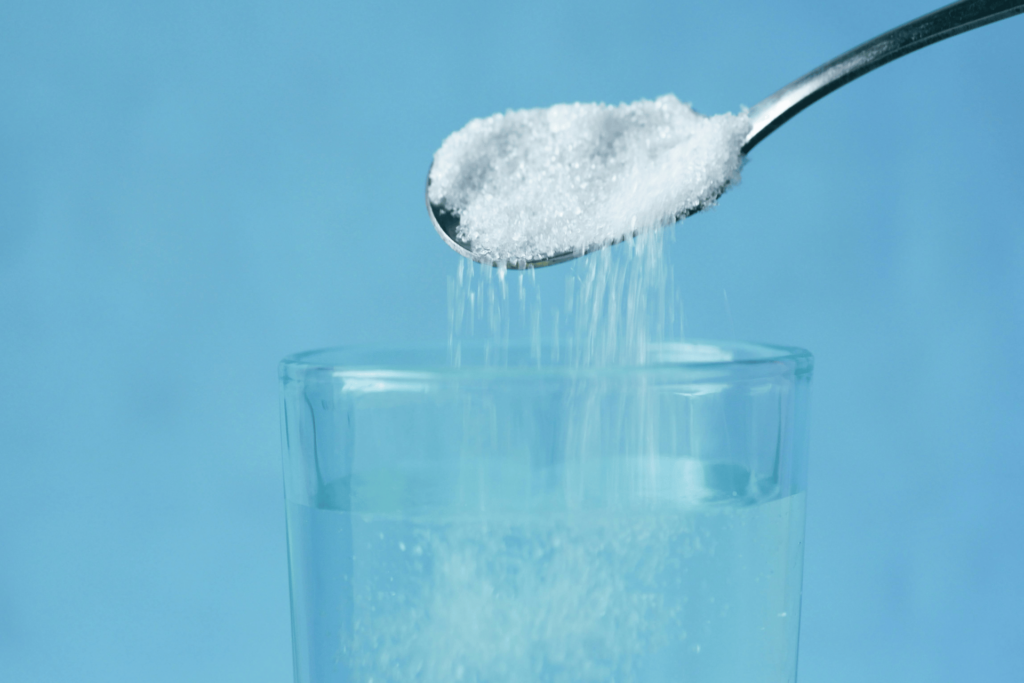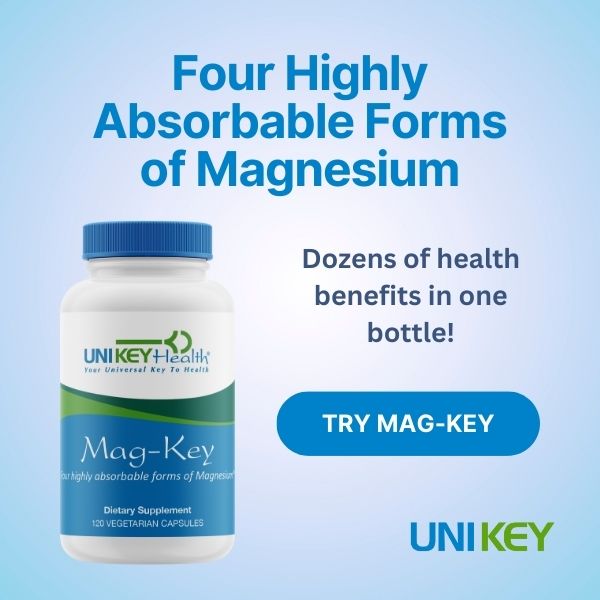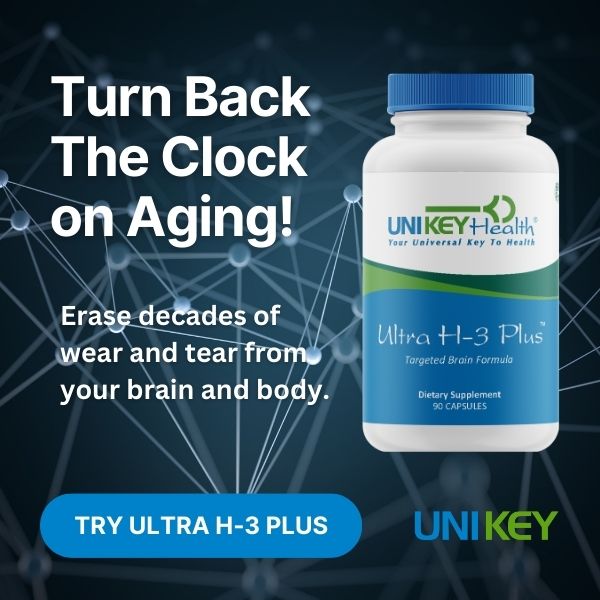Brain food that heals the gut, maintains muscle mass and fortifies immunity.
The fall always reminds me of my experience over twenty years ago when I was writing my first book, Beyond Pritikin (Bantam, 1988).
Back then (in the mid 1980s), I worked with an extraordinarily fast computer whiz, Chris, who transcribed my handwritten manuscript. Because of Chris’ schedule we often had to work through the night.
Chris was so capable and helpful, that I agreed to stay up and work alongside her. I marveled at Chris’ consistent mental focus—even after a full day of “regular” work with her 9 to 5 job.
What was Chris’ energy secret?
She kept herself going through the night by taking a scoop of a special amino acid every three hours which she told me provided her with an alternative fuel source for the brain.
This powdered amino acid that she mixed in cold water—known as l-glutamine—was recommended to her by a nutritional biochemist who told her the drink would keep her brain alert and tummy trim.
I never forgot about Chris’ instant brain and “tummy” food.
So I was not surprised years later to learn of more breakthrough discoveries about the many therapeutic values of glutamine, officially classified a “nonessential” amino acid.
Healing with Glutamine
From my review of the literature, glutamine appears more to be an essential nonessential amino acid. It has the ability to cross the brain/blood barrier and is a remedy for recovering alcoholics and sugarholics. It aids concentration and memory.
Glutamine also has more far reaching effects, it…
- Fights cancer
- Reduces the toxicity of chemotherapy and radiation
- Slows down the aging process
- Nourishes and protects the liver from acetaminophen damage
- Boosts the immune system
- Prevents muscle breakdown
- Heals the stomach and intestines
It is indirectly related to the antioxidant family because it functions as an anti-inflammatory precursor for glutathione, the key free-radical scavenger of the body. Glutamine works faster than most other therapies for a multitude of conditions.
While research has proven glutamine’s effects on Crohn’s disease, ulcerative colitis and irritable bowel syndrome, I have seen firsthand how it can heal leaky gut syndrome in a three week period of time—another one of its major claims to fame.
Glutamine helps maintain the proper permeability of the small intestine. Without it, the villi become too porous. Molecules enter the system that normally would be too large to breach the intestinal wall. That results in substances being allowed into the bloodstream that can cause allergic reactions and other problematic responses.
On the other hand, glutamine helps the lining allow the proper nutrients into the body while barring the entry of allergens. Along with allergens, when your GI tract is damaged or stressed, microbes and the toxins they secrete can also find their way through the intestinal walls and lead to infection.
Here too, glutamine helps keep these nasty substances out by aiding and creating a barrier that protects the body. In addition, the cells of the intestinal walls responsible for choosing which nutrients are permitted into the body are fueled by glutamine.
Researchers have found that besides feeding the cells in the intestines and putting up barriers to pathogens, glutamine helps boost the growth of probiotics, which in turn also help defend the intestinal walls against pathogenic invasion. When researchers gave glutamine to people with ulcerative colitis, they found that it reduced intestinal inflammation and their probiotic bacteria flourished as well.
Adding Glutamine to Your Diet
Glutamine works best one or two hours before or after meals because digestive acids destroy its activity. It is found in many food sources but can become easily denatured and therefore inactivated when cooked.
So while eggs, meat, chicken and fish are the highest sources, the glutamine these foods contain is biochemically unavailable unless of course you consume these foods in the raw state which is inadvisable due to obvious reasons including bacteria and parasite contamination. 
So here’s a clear case where whole food sources may not be enough for therapeutic benefits.
That’s where supplementing with Glutamine powder comes in handy.
Taken between meals as a healing aid for the GI tract or as Chris’ original “brain and tummy food” to keep blood sugar steady, glutamine can be consumed in the amounts of 1,500 to 3,000 mg daily in divided doses.
It’s best to mix the powder in cold water. The recommended daily dosage can considerably increase to protect the body from the devastating effects of a variety of stressful assaults. Much higher doses (from 20,000 to 40,000 mg) have been administered following surgery or radiation and chemotherapy.
In times of stress such as trauma, fever, illness, chemotherapy or even dieting, the body cannot make as much glutamine as it needs, so supplementation is absolutely essential.
It’s time that glutamine becomes reclassified as a conditionally essential amino acid because it is critical when the body is under stress or fending off dis-ease. It is a wonderful catalyst that helps the body heal itself at pennies per day!
References:
Gittleman, Ann Louise. The Gut Flush Plan. New York: Avery, 2009.
Shabert, Judy, and Nancy Ehrlich. The Ultimate Nutrient, Glutamine. New York: Avery, 1994.










38 Responses
What an interesting blog. I am going to add Glutamine to my supplements today.
I used glutamine for years to heal my leaky gut and restore muscle strength. It is very underrated and I am glad that you are bringing it to a new audience!
Ann Louise, Thank you for this blog!!! Where would you suggest I get this marvelous nutrient?
Dear Kathleen:
If you are a UNI KEY customer, you can get a 3,000 mg glutamine powder from them directly! They distribute the Carlson Glutamine that I personally use myself. Good luck, my dear.
Hi Ann Louise,
I am currently between jobs. I am pretty sure I have a parasite(s), as I have had them twice in the past (found through testing), and the 2nd time I got rid of them using your parasite cleasing herbs. (Before you had the Colon Cleansing Kit even.) My question is, I have a huge jar of glutamine powder but am not taking it right now. I am having tons of food intolerances and supplement intolerances and even bad headaches often in the night. I can’t get the testing done for parasites and yeast for awhile (after I get work again). I wonder if the glutamine might help my symptoms. I also have the Parasite cleansing herbs from your colon cleansing kit but they make me so sick that I have to quit after the first day. (Horrid headache that lasts a couple of days that no over-the-counter medication will help.) That is why I decided I wanted to wait until I got tested so I know exactly which parasites I am dealing with. I respect your knowledge so much! Followed you and read your books on menopause and premenopause and parasites also. Thank you!
Dear Sabrina:
I would not hesitate to recommend the glutamine powder to you. I would take a scoop (or one serving or teaspoon) 1/2 hour before meals. Mix the powder with cold water and drink! It is helpful to restore the gut lining and can heal ulcers. I am sure it will also indirectly help your beneficial flora and thus help your system stave off yeast and the devastating effects of parasites. After a month on the glutamine, you might consider using the Colon Cleansing Kit Para Key and Verma Plus at half the recommended dosage and see how your system can tolerate these products. Slowly but surely we will fortify and regenerate the gut lining so it will be able to better shield you from hidden invaders and microbes.
Oh, bless your big heart Ann Louise! I will start the glutamine today! I did just notice that my jar of Glutamine is 5,000 mg. per scoop. I don’t think I want to take that much at one time yet. Will have to figure out how much of the scoop is 1,000 mg. lol I am going to take your advice and try my herbs from Unikey’s Colon Cleansing Kit again in one month at half the dosage, I did notice that my headaches got worse when I recently ran out of Unikey’s probiotic powder. You made me feel so encouraged! I get down sometimes about these critters in my gut. I know so many of the symptoms after having them for many years in the 1990’s before I got diagnosed and eradicated. They can cause so many WEIRDE symptoms. Blessings to you. THANK YOU SO MUCH!
Hello! I just wanted to give an update; hopefully my experience can help others with leaky gut syndrome and parasites in their gut.
I have been taking one teaspoon or 1,000 mgs. of glutamine 30 minutes before each meal (3 times a day) for nearly 5 days now as recomended by Anne Louise. (see above) My excrutiating headaches that were coming on almost every night between 2 and 3 am. (liver cleansing time!), stopped immediately! I still wake up with a very mild sinus headache but it goes away quickly with one cup of green/ginger tea, but I also increased the ginger to 2 teabags (and 1 green tea bag.) Both organic.
My bowels have actually been moving more often with looser stools (but not diarrhea at all).
I am not getting any headaches immediately after I eat either, which used to occur frequently.
I have one question for Dr. Gittleman:
When I start the Colon Cleasnsing Kit again in a month (as suggested by you), with the parasite-cleansing herbs, do you recommend that I continue taking the glutamine every day? Perhaps between meals rather than 30 minutes before. As I write this, I think I answered my own question. I know the parasite-cleansing herbs are taken between and before meals, so I could also take the glutamine away from those herbs, but also between meals! I think I have a plan! (smile)
Thank you again for getting me on the right track for conquering these headaches, which had been plagueing me for 10 years or more. I had tried glutamine earlier this year, but I was taking too much. I was having lots of bloating then, and I took 5000 to 10,000 mg. in water on an empty stomach, but it made the bloating worse! So I cut it out completely. This article on glutamine by Dr. Gittleman this past week was definitely an answer to many prayers from me asking for help with the pain! What a Godsend you were, Anne Louise!
Dear Sabrina:
We are so happy that you have gotten such wonderful results from the low dose glutamine suggested in Ann Louise’s blog!
With regard to the timing of the glutamine, we suggest (as you so astutely observed) that between meals would be ideal in light of the before meals colon cleansing protocol.
Keep up the good work and may your healing continue!
Can glutamine and Flora be mixed together?
Dear Marilyn:
You pose an interesting question. I do not see why they both cannot be taken together as long as both are ingested on an empty stomach. Glutamine definitely needs to be taken without food for the most complete absorption and healing benefits.
My father, 87 yrs old, has been suffering with terrible constipation, bloating and pain for many years. Several years ago, an alternative physician prescribes glut amine to him. My dad’s constipation got worse, perhaps by coincidence. The physician advised to keep taking it, but my dad was getting worse and discontinued the treatment. At present, he is on probiotics and bone broths( that I know contain glutamine), I would like him to try the powder again., since I find it more convenient and I can control the dosage. Do you have any suggestions ?
Dear Sophia:
Glutamine is often prescribed for diarrhea and as such I believe it possesses a more stringent rather than “relaxing” effect on the GI tract. That being said, if your dad’s constipation is under control with the right type of probiotics, fiber, and bone broths (a great source of “natural collagen”), then taking 1/4 tsp of the glutamine powder twice per day would be a good starting dosage. Slowly increase to bowel tolerance until one teaspoon twice per day can be assimilated without any uncomfortable side effects or bloating. Glutamine is an extremely important supplement for our senior citizens and protects the stomach and liver from the negative impact of medications.
I eat Whey Protein as a source of protein every day. I very often mix it with yogurt or tea. The Whey Protein I am currently buying has 3.06g of “Glutamine + Glutamic Acid” per serving. I read your recommendations for taking Glutamine on an empty stomach with cold water. If you regularly eat Whey Protein, are you getting some of the benefits you describe in this article? Would it help to mix the Why Protein in cold water (or tea) first thing in the morning? I’ve been eating Whey Protein for muscle strength for some time now. I have osteoarthritis in both knees/legs – and Whey Protein is part of my diet and nutrition to help with walking (and it does). If I would get Glutamine Powder to take in addition to eating Whey Protein, do you recommend a different amount than given in this article because someone eats Whey Protein regularly?
Dear Ruth:
You are certainly on the right track by eating your whey protein on a daily basis. It is one of the naturally high sources of glutamine – and as such it helps to form glutathione, the most powderful antioxidant in the system. Enjoying whey protein in cold water is a great idea so you don’t further denature this precious esential non-essential amino acid.
In addition, we recommend 1/4 tsp of the powder taken by itself before or between meals at least twice per day to give your whey protein powder a boost. Glutamine seemes to work best therapeutically when it is taken by itself and not in conjunction with other aminos.
Best of health and good luck to you, too!!
Hi, I have been off sick with Epstein Barr for two months. I have had friends suggest all kinds of herbal products. I have spent over $200.00 from pills to drops etc. I have gotten so sick on these products and now am at my wits end. My girlfriend from Austin sent me this site. I am 68, losing muscle strength and mass daily. I am usually pretty healthy and strong but this time which I have had Epstein Barr 3 years ago has left me weak and no strength at all. My system is extremely sensitive. Have you any suggestions for me. I have no hormones and my friend has suggested doing bio identical. I have tried creams, pills, jellies etc. I have no desire to do anything socially, no energy and most of all no emotions. I have had my hormone levels checked and I have none. She has suggested I go to a doctor in Dallas that does a 20 panel blood test and go from there. I have heard taking hormones at my age will cause cancer. What is a woman that is basically a young 68/ 55 year old to do. Any advice would be so appreciated.
Dear Diana:
We would recommend a variety of anti-virals for you like Olive Leaf Extract, Cat’s Claw and even the amino acid L-Lysine at 3,000 mg per day. (Do follow the directions for the Olive Leaf Extract and Cat’s Claw.)
You might also contact UNI KEY at 1-800-888-4353 and speak to Sierra about ordering a salivary test for all six hormones (estradiol, estriol, progesterone, DHEA, testosterone, and cortisol) that can dramatically effect immunity.
Taking ALG’s recommended dose of L-Glutamine between meals can help restore musle strength as can Whey protein powders like our Fat Flush Whey which is non-denatured, hormone free and free of sugars and artificial sweeteners. You may also need adrenal supplementation which the salivary hormone can start to access and hopefully address. Good luck and best wishes.
i eat 3 eggs daily, raw, in my green smoothie…with coconut oil :). i know many mnay ppl who do so also. i have fed my children them from 18 mos old, when they were drinking smoothies too. i know many many ppl who have also done so. i have 5 kids btw, its not just a fluke. most of my many many friends average 10 kids each. we’re talking a large number of ppl.
raw eggs are not a health risk. it is a widely disseminated untruth. still, an untruth.
i would not eat raw meat, however, without freezing it 1st for 14 days. then i would certainly enjoy steak tartare or cerviche. i dont eat pork, squirrel, raptors and other rodents as they are not food but the garbage clean up patrol for our Earth. so the incidence of infestation in my meat is probably quite low anyway.
off to google how much glutamine per egg! yay!
Guess what Helene? I know many, many “ppl” and friends and clients who have consumed raw eggs in their smoothies and ended up with “hidden” infections of salmonella or H.pylori. So ALG’s recomendations to avoid raw eggs, meat, fish and poultry are right on target – as usual. Unless you have tested as many clients over thirty years as I have and she has, I know, you ought to be a alot more respectful an expert’s research and hands-on experience in this area.
As a functional medicine consultant, I completely agree with her recommendations to avoid raw food as I have found a huge number of clients that have suffered for years with lingering infections because of raw foods.
Freezing meat, poultry, and fish may theoretically “kill” parasites I’m told but most people enjoy their food cooked and sushi is filled with parasitic organisms and other fish worms.
No nutritionist in their right mind would tell somebody to ingest raw eggs, meat, poultry, and fish.
Ditto for me, Pamela — I completely agree with you!!
And me — I used to put raw egg yolks in my smoothies until my youngest started complaining of stomach aches and we had the whole family tested for pathogenic bacteria. Even though no one else had symptoms, we all had salmonella and my son also had H.Pylori. Bacterial infections are insidious and don’t always make you “sick” right away but seem to lie dormant until the immune system becomes week and then they spring to life.
I am so glad to have Ann Louise’s blogs. Her advice has been spot on for over five years… Thanks
I’m going to order the glutamine today to heal the H.Pylori residues in my son’s tummy.
A quick thank you for writing about topics that are really newsworthy and not just a rehash of everything else out there. Your blog is refreshing because it is interesting and not too academic or laden with scientific references. You distill nutritional pearls of wisdom and make them very palatable and understood by all ages.
Thanks for all your supportive comments!
I have had on and off gut problems for several years. For over 15 years, I have been doing the smoothies in the am (from the original Fat Flush program). And for 25 years, I have been making my own green drink, organic spinach and kale or chard, parsley, and I have been using more and more greens, which I blend in my VitAMix, strain and dilute with water to drink all day. Lately I have noticed that the more greens I use, the more I have loose stools. I have also developed a sore mouth. For over a month, I thought I had a yeast condition in my mouth, sore, swollen, super dry (like sand paper) and tender. But I went on a vacation and didn’t do the green drink for 10 days. My condition went away for the first time in a month and a half! I have read about an abundance of oxalic acid from too many greens. So I am putting only the low oxalic greens in my green drink. But my gut is still very sensitive. Have you ever heard of this happening? I am sure that the glutamine that you mention would help me as well! Thanks so much for your advice!
Dear Diana:
I think the glutamine will be most helpful for your sensitive GI tract, first and foremost.
Juiced greens high in oxalic acid like kale, spinach, and chard can negatively impact the body for many indiivduals which is why juicing is great – with more low-oxalic veggies like cucumber and celery and a small amount of carrot.
I have worked with many clients recently who have had to modify their green smoothies due to symptoms like yours, so you are not alone. Vegetables are designed to be eaten whole and when we overly juice certain ones, toxic side-effects can occur. Sounds like you are on the right track now and the glutamine may be just the remedy you need!
Hello Adrian:
Don’t give up hope and do try the low dose glutamine suggested in the blog. The biochemical truth of the matter is that most individuals have no problem supplementing with the moderate amounts of glutamine powder between meals.
While glutamine can convert into the excitotoxin-glutamate, the biochemical bias for the majority is to convert into GABA which is soothing and calming. I have tested thousands of clients over the years and the great majority that have gut issues, muscle weakeness and brain fog are all glutamine deficient and have benefited from the amounts detailed above. If you are still unsure, give yourself a short-term trial and see how you do or get yourself tested if you can and track your baseline levels.
After reading this blog, I bought some glutamine powder and started taking it yesterday. Is there a preferable time to take it? Would it be OK to take it with my Super GI Cleanse first thing in the morning? Also, I read in another book on nutrition glutamine can help with insomnia. I’m sure hoping that will be another added benefit.
Debbie:
As long as you take the glutamine without food and mixed in cold water, you are good to go! Many of my clients take it with other supplements but not other amino acids.
My daughter has crohn’s disease. Several years ago she had a bowel resection done. They removed the terminal ileum. This has sped up the process and doesn’t allow the large intestine to absorb the fluids and acids. Resulting in diarrhea for 3 years. That as lead to anal fissures. Would taking the Glutamine help her condition and slow down the process, help her with absorption of nutrients and stop the diarrhea.
Marian:
I would definitely give the glutamine a try because it is so helpful in mitigating diarrhea. Glutamine fortifies all mucus membranes. I would start with 1/2 the recommended dose (in this case 1,500 mg) in the powdered form mixed in cold water and do this twice a day. Anxious to hear how your daughter does with this supplement!
Hello Anne, I have just purchased the l-glutimine in hopes of restoring my gut. approximately 1 1/2-2 years ago I read your fat flush and started applying some of the principles. I removed all white stuff and sugar. The next step I took was juicing. After about 2 months of juicing I started to have a rash in my face and arms. I was advised by my naturopathic dr I needed to do candida and parasite cleanse. No better after cleanses. Then I added cultured veggies and kefir (which I loved) but they did not seem to love me back. I ended up after months of tormenting itching coming off everything and just trying to eat balanced meals. I went to the dr several times was told I had eczema. I had also been taking clay baths to pull out the toxins while juicing. I ended up getting a steroid shot to stop the itching. I still occasionally have some minor itching but no rashes. I never had eczema in my life. I am almost 55 years old. Now I do the bone broth and have seen some results.I take a little green foods powder once in a while but can still get a little itchy from even a small amount. Loved the juicing but now I am title shy about any of wonderful benefits :):) do you have any insight or suggestions for me? Thank you so much for all your wisdom.
Also Anne I wanted to ask when I take the lglutamine in the morning do I take it before lemon water , coffee or tea? Should it be the first thing in the morning? Thanks!
Hello Rita:
We are very hopeful that the glutaminee recommended in Ann Louise’s blog will be of help to you. It can be taken right before your lemon and water in the AM.
So sorry to hear of your skin issues. Juicing – while helpful for many conditions – is not part of a long term Fat Flushing protocol because there are so many detox variables that need to be addressed on a highly individualized basis.
For example, the oxalate content of commonly juiced fruits like berries or greens like chard and spinach can precipitate a cleansing crisis and deposit crystals in joints or even kidney stones. And sometimes, the excess sugars from too many fruits or carrots can trigger yeast.
We would recommend that you continue with your bone broth and greens powder, the glutamine as well as our Y-C Cleanse (yeast fighter) and Flora Key to maintain immunity.
Our Liver-Lovin’ greens Formula, by the way, does not contain the oxalate containing greens nor heavy-metal containing sea veggies and is a much more gentle source of cleansing chlorophyl that is hypoallergenic and well tolerated by everybody.
Thank you so much for your advise. Will definitely follow through with Fat Flush diet and recommended supplements.
Although I have been adding l glutamine to my protein shake in the morning rather than taking it alone, I am experiencing great benefits. There is no afternoon slump from 3 – 7pm and I wake up starving in the mornings due to the digestive aid it provides.
2 Questions – 1)can a lactose intolerant person take it? 2) would it benefit my mother who has dementia with her memory issues?
Thank you, Ann!
Avid follower
Dear Joan: Happy to hear of your beneficial results using l-glutamine. I see no reason a lactose-intolerant person shouldn’t take the l-glutamine. While this amino acid can help with blood sugar stabilization, I don’t think it will be therapeutic enough to offer much help with your mother’s dementia. But, Ultra H-3 may help as well as one tablespoon twice per day of coconut oil!
Good luck to you, Joan and thanks for your post.
When shopping from the internet, a numeral of hoi polloi frequently claim prison term to register through with a duet of reviews on the mathematical
product earlier qualification a buy. This is because; online mathematical product reviews portray the diverse opinions from those WHO get bought the products in front.
Thus, it would be allow to tell that online intersection reviews stool
experience an impact on the sales of those products.
The affect of online product reviews on gross revenue backside either be
empiricism or disconfirming founded on the timbre and personal manner in which they are written. At times, it sack likewise be founded upon the mass who write them.
However, it should be famed that an ideal online
merchandise recap should be understandably
written founded on the customer undergo and non whatsoever former personal reasons.
That is the just style through and through which
they rear end be useful to you as the byplay possessor and your perceived customers.